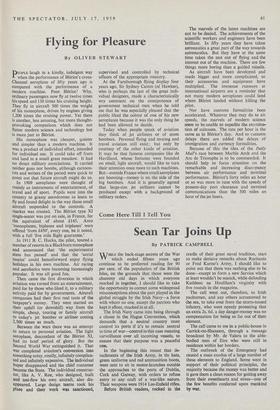Flying for Pleasure
By OLIVER STEWART
PEOPLE laugh in a kindly, indulgent way when the performance of Bleriot's cross- Channel aeroplane of fifty years ago is compared with the performance of a modern machine. Poor Bleriot! Why, ordinary passengers now fly at twelve times his speed and 130 times his cruising height. They fly in aircraft 500 times the weight of his monoplane, driven by engines giving 1,200 times the cruising power. Yet there is another, less amusing, but more thought- provoking comparison which does not flatter modern science and technology but is more just to Bleriot.
His monoplane was cheaper, quieter and simpler than a modern machine. It was a product of individual effort, intended for individual use. It could take off from and land in a small grass meadow. It had no direct military associations. It carried neither guns nor bombs, although cartoon- ists and writers of the period were quick to point out that future aircraft might do so.
In 1909 aeroplanes were thought of mainly as instruments of entertainment, of travel and of sport. Pupils went into the country to grassy aerodromes to learn to fly and found delight in the way those small aircraft responded to the controls. A market was created. The Bleriot type XI single-seater was put on sale, in France, for the equivalent of about £145. Avro 'Monoplanes, biplanes and triplanes' were offered 'from £450', every one, be it noted, with a full 'five mile flight guarantee.'
In 1911 B. C. Hucks, the pilot, toured a number of resorts in a Blackburn monoplane and announced that 'the experimental state has passed' and that the 'aerial tourist' could henceforward enjoy flying holidays in his own machine. Air racing and aerobatics were becoming increasingly Popular. It was all good fun.
Then came the first diversion in which aviation was turned from an entertainment, Paid for by those who liked it, to a military activity paid for by governments. Aircraft companies had their first real taste of the taxpayer's money. They were started on their uphill (or downhill) way from the simple, cheap, touring or family aircraft to today's jet bomber or airliner costing 2,500 times as much.
Between the wars there was an attempt to return to personal aviation. The light aeroplane, descendant of the Bleriot XI, had its brief period of glory. But the Second World War extinguished it. That war completed aviation's conversion into something noisy, smelly, infinitely complica- ted and infinitely expensive. The individual buyer disappeared and the chief customer became the State. The individual construc- tor, like A. V. Roe, who designed, built and test-flew his own aircraft, also dis- appeared. Large design teams took his
Place and their work was sanctioned,
supervised and controlled by technical officers of the appropriate ministry.
At the Farnborough flying display four years ago, Sir Sydney Camm (of Hawker), who is perhaps the last of the great indi- vidual designers, made a characteristically wry comment on the omnipotence of government technical men when he told me that he was especially pleased that the public liked the colour of one of his new aeroplanes because it was the only thing he had been allowed to decide.
Today when people speak of aviation they think of jet airliners or of atom bombers. Personal flying and touring and travel aviation still exist; but only by courtesy of the other kinds of aviation. It may be that famous companies like de Havilland, whose fortunes were founded on small, light aircraft, would like to turn their attention once more to such machines. But—outside France where small aeroplanes are booming—money is on the side of the big bombers. And it is generally agreed that large-size jet airliners cannot be produced except with a background of military orders. The marvels of the latest machines are not to be denied. The achievements of the scientific workers and engineers have been brilliant. In fifty years they have taken aeronautics a great part of the way towards astronautics. But they have at the same time taken the zest out of flying and the interest out of the machine. There are few things more boring than a guided missile.
As aircraft have been developed and made bigger and more complicated, so their accessories and equipment have multiplied. The immense runways at international airports are a reminder that not many modern aeroplanes could land where Bleriot landed without killing the pilot.
Nor have customs formalities been accelerated. Whatever they may do to air speeds, the marvels of modern science seem to be unable to expedite the examina- tion of suitcases. The rate per hour is the same as in Bleriot's day. And to customs delays there are added the delays of immigration and currency formalities.
Because of this the idea of the Daily Mail's race between Marble Arch and the Arc de Triomphe is to be commended. It should help to focus attention on the remarkable and increasing disci epancy between air performance and terminal performance. Bleriot's forty miles an hour or so was more in tune with the speeds of present-day port clearance and terminal communications than the 500 miles an hour of the jet liners.






































 Previous page
Previous page